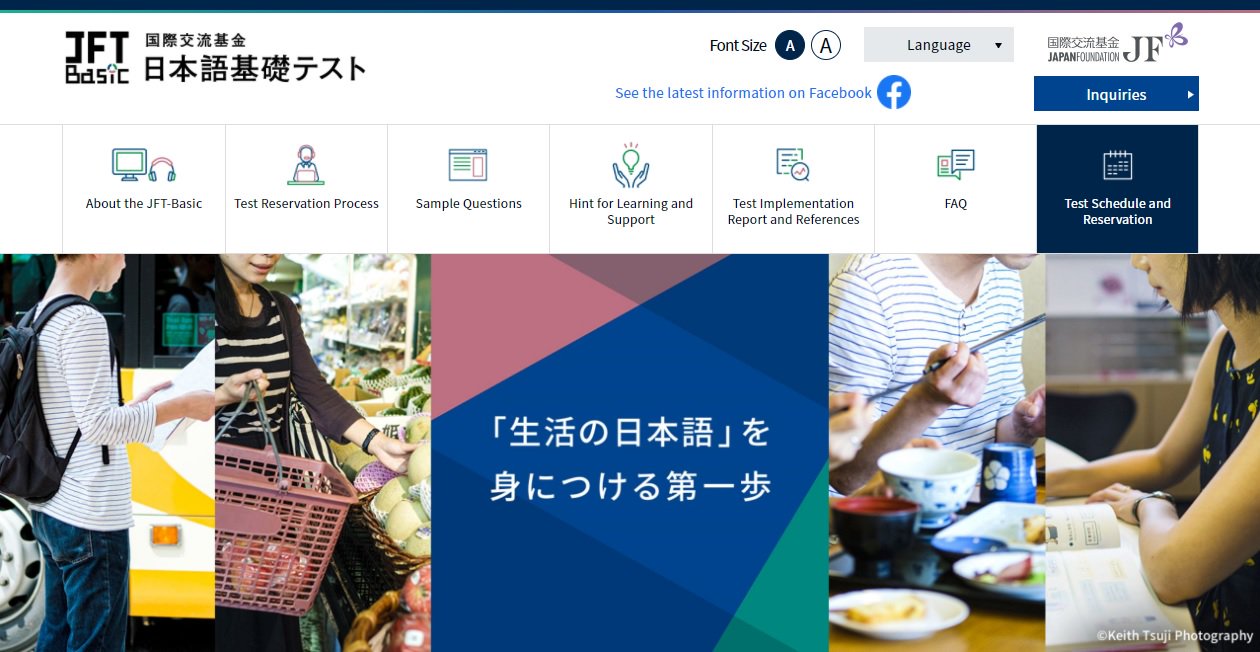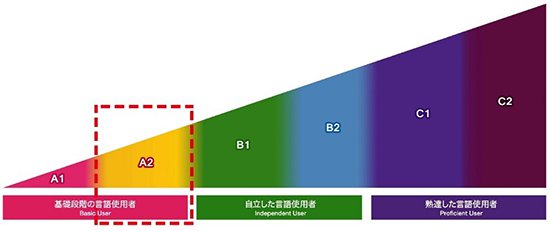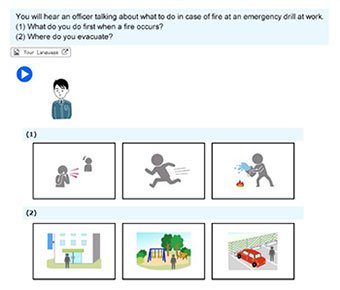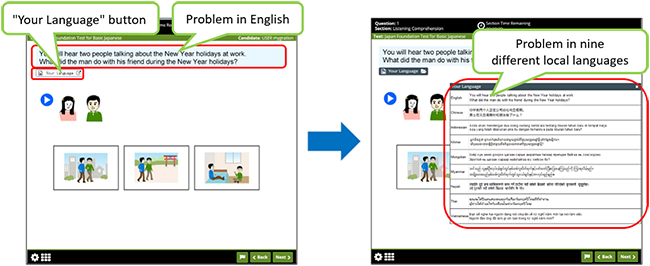The Japan Foundation Test for Basic Japanese (JFT-Basic) to Measure Japanese Language Proficiency Required for Life in Japan
- Nihongo Kyoiku News
- This corner introduces the latest information on matters of high interest to overseas Japanese-language educators from among the Japanese-Language Education Programs conducted by the Japan Foundation.
September, 2021
The Japan Foundation Japanese-Language Institute, Kansai
The Japan Foundation Test for Basic Japanese (JFT-Basic) seeks to measure the level of Japanese language proficiency needed by foreign nationals about to reside in Japan mainly for work, in order to communicate in everyday life situations. This test is used to assess whether they have the proficiency to engage to some extent in everyday conversation and handle daily life without difficulties. In this article, we would like to give a brief overview of JFT-Basic, the state of test implementation, and the feedbacks we received since its launching in April 2019.
Used for assessing Japanese language ability for the Specified Skilled Worker(i) residency status
The test is for foreign nationals who are not native speakers of Japanese. In particular, it is aimed for foreign nationals about to reside in Japan mainly for work. It is also used as a test to assess whether the level of Japanese language ability needed to obtain the Specified Skilled Worker(i) residency status, which was launched in April 1, 2019, has been reached.
Developed based on approaches by CEFR and JFS, using A2 level proficiency as a guideline
The JFT-Basic was based on approaches by the Common European Framework of Reference for Languages: Learning, Teaching, Assessment (CEFR) and the JF Standard for Japanese-Language Education (JFS), which was developed by the Japan Foundation in accordance with the CEFR. The test was developed using descriptors of linguistic competence (Can-do) as reference to indicate the kind of tasks that can be accomplished using Japanese. It is used to assess whether test-takers have the "ability to engage in everyday conversation to a certain extent and handle daily life without difficulties," using Japanese proficiency at the A2 level as a guideline.
Contains four sections: Script and Vocabulary, Conversation and Expression, Listening Comprehension, and Reading Comprehension
The test contains four sections: Script and Vocabulary, Conversation and Expression, Listening Comprehension, and Reading Comprehension.
Each section is further divided into several categories, for a total of about 60 questions.
| Section | Purposes of the section | Category | Purpose of category |
|---|---|---|---|
| Script and Vocabulary (Around 15 questions) |
To test if the test-taker is able to read Japanese texts used in everyday situations, and whether the test-taker has the basic vocabulary and is able to use it. | Word meaning | To test the meaning of a word. |
| Word usage | To test the usage of a word. | ||
| Kanji reading | To test the hiragana pronunciation of a word written in kanji. | ||
| Kanji meaning and usage | To test the meaning and usage of a word written in kanji. | ||
| Conversation and Expression (Around 15 questions) |
To test if the test-taker is able to use the grammar and expressions necessary for conversation in everyday situations. | Grammar | To test if the test-taker can use the appropriate grammar matching the context. |
| Expression | To test if the test-taker is able to use the appropriate expression matching the context. | ||
| Listening Comprehension (Around 15 questions) |
To test if the test-taker is able to listen to and understand conversations, instructions, etc. in everyday situations. | Comprehending content (conversation) | To test understanding of contents by listening to an exchange of information or social exchange. |
| Comprehending content (communicating at shops and public places) | To test understanding of contents by listening to an exchange at a shop or public place. | ||
| Comprehending content (listening to announcements and instructions) | To test understanding of contents by listening to instructions and announcements, audio media, etc. | ||
| Reading Comprehension (Around 15 questions) |
To test if the test-taker is able to read and understand letters, notices, explanations, etc. in everyday situations. | Comprehending content | To test reading of a short and simple letter, message, etc. |
| Information search | To test if the test-taker is able to find the necessary information from an everyday billboard, notice, information material, etc. |
Questions are based on A1 to A2 levels of Can-do in the CEFR and JFS
The questions given in the test are based on A1 to A2 levels of Can-do in the CEFR and JFS. For each section and category, the questions are prepared to match three levels of CEFR Can-do: A1, A2.1 and A2.2. Furthermore, for each question, specific situations and topics are set based on Can-do examples selected from the JF Can-do list (A1 and A2 level) and the JF Can-do for Life in Japan list .
Questions are focused on daily life situations
The test is mainly for foreign nationals coming to live in Japan for work, so the questions given are focused on situations in daily life and for communication at work, which does not depend on any specific occupation. From the perspective of acquiring the necessary skills for living in Japan, the situations include not just topics related to shopping and transportation, but also to hospitals and disaster preparedness. In the Reading Comprehension section for example, the reading materials include letters, emails, social media posts and other types of messages, everyday signs, notices, medication prescriptions and other texts encountered in daily life. Assuming situations where the test-taker will actually use the Japanese language while living in Japan, the questions are set from the standpoint of carrying out the tasks given in each Can-do.
Sample question
As an example, the following is a question from the Listening Comprehension section, Comprehending Content (Listening to Announcements and Instructions) category.
● CEFR Can-do : LISTENING TO ANNOUNCEMENTS & INSTRUCTIONS (A2)
“Can catch the main point in short, clear, simple messages and announcements.”
● Can-do example : JF Can-do for Life in Japan Can-do 303
“Can listen to simple instructions about disaster prevention in one’s area if the speech is slow and clear, and understand, for example, evacuation sites and precautions for evacuation in reference to illustrations and photos, such as in brochures.”
Listening Comprehension sample question
The question refers to the CEFR Can-do for Listening to Announcements and Instructions (A2). The Can-do example shows a task to listen to the person in charge of the fire drill at work talking about what to do when a fire breaks out, and assesses whether the test-taker was able to listen and understand "what to do first" and "where to evacuate." It is a question measuring whether the test-taker can accomplish the task from the standpoint of "listening" at fire drills and other situations that are often encountered in Japan.
Conducted through the Computer-Based Testing (CBT) method
The test is conducted through the Computer-Based Testing (CBT) method. Test venues and test periods are set for each country, then the tests are carried out on multiple dates and time slots within the test period. This means that the test-taker can choose a convenient date and time to take the test.
At the venue, the test-taker answers on the computer screen based on questions displayed onscreen and audio played through headphones in booths. The test is taken in order by sections, from Script and Vocabulary, Conversation and Expression, Listening Comprehension, and then to Reading Comprehension, although there is no time limit for answering each section. Thus, the questions in all sections can be answered at their own pace within the 60-minute time limit.
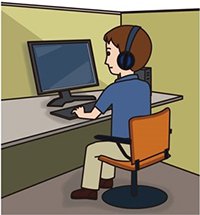
Taking the test
Test questions and choices are displayed on the computer screen. Problems are displayed in English. Clicking on the "Your Language" button at the top left of the question screen will display the problem in nine different local languages. The test-taker can then read the problem in a language they understand and answer after comprehending the situation and condition.
Question screen
Screen after clicking on the "Your Language" button
For test results, the total score and assessment results are displayed on the screen at the end of the test, so the test-taker can check the assessment results immediately after taking the test. Moreover, they can check and print the official notification of assessment results themselves on the registration website within five business days after taking the test.
The notification of assessment results contains the examinee information, test information, total score and assessment results based on the score. The total score ranges from 10–250 points, with the test-taker assessed as having reached a level of Japanese language proficiency to be able to engage in everyday conversation to a certain extent and handle daily life without difficulties if the total score is at or above the passing score (200 points).
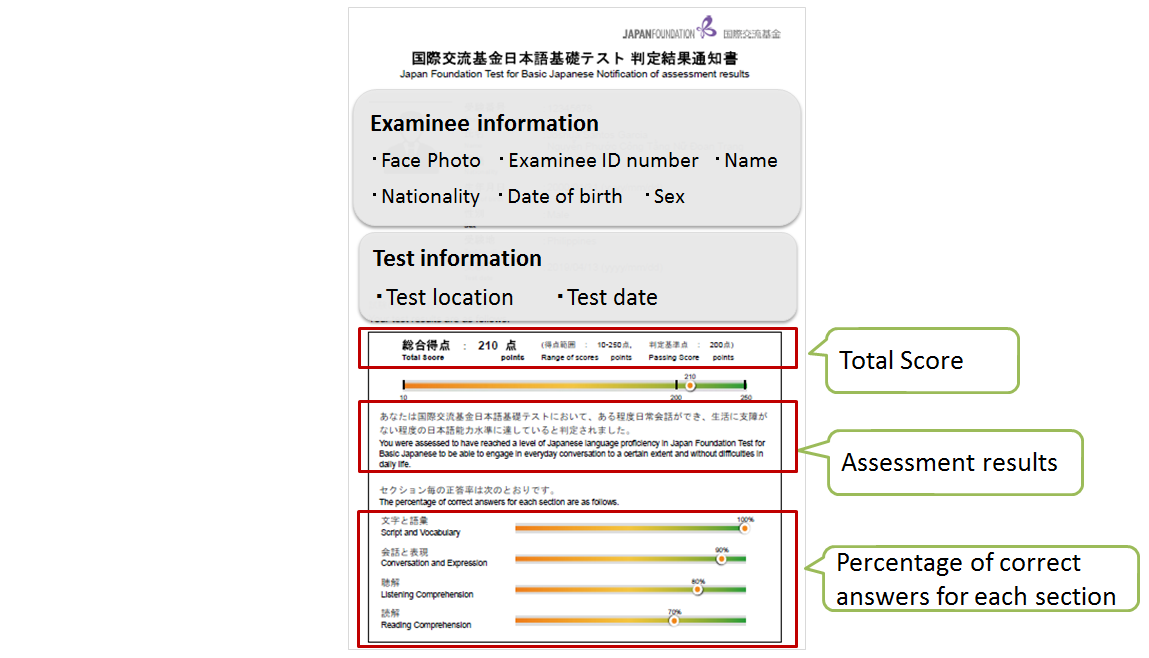
Notification of assessment results
Test implementation in various countries and launching in Japan
The JFT-Basic began in April 2019 and is carried out six times a year. As of March 2021, it has been carried out 14 times with 25,553 test-takers in Japan and seven other countries (Philippines, Cambodia, Indonesia, Nepal, Mongolia, Myanmar and Thailand).
| Test period | Philippines | Cambodia | Indonesia | Nepal | Mongolia | Myanmar | Thailand | Japan | Total | |
|---|---|---|---|---|---|---|---|---|---|---|
| FY2019 | Apr | 57 | 57 | |||||||
| May | 110 | 110 | ||||||||
| Jun | 160 | 160 | ||||||||
| Aug | 133 | 133 | ||||||||
| Sep | 189 | 189 | ||||||||
| Oct-Nov | 642 | 91 | 340 | 497 | 60 | 1,630 | ||||
| Jan | 738 | 118 | 410 | 625 | 1,891 | |||||
| Mar | 928 | 166 | 841 | 701 | 1,165 | 3,801 | ||||
| FY2020 | May | 92 | 92 | |||||||
| Jul-Aug | 298 | 156 | 1,551 | 278 | 2,283 | |||||
| Sep | 468 | 79 | 448 | 282 | 84 | 1,361 | ||||
| Nov | 549 | 125 | 1,586 | 865 | 16 | 52 | 3,193 | |||
| Jan | 651 | 169 | 1,682 | 507 | 275 | 3,284 | ||||
| Mar | 681 | 142 | 3,248 | 611 | 76 | 82 | 2,529 | 7,369 | ||
| Total | 5,604 | 1,138 | 10,106 | 4,366 | 236 | 1,440 | 134 | 2,529 | 25,553 | |
| City | Manila/ Cebu/ Davao |
Phnom Penh | Jakarta/ Surabaya/ Bandung/ Yogyakarta/ Medan |
Kathmandu | Ulaanbaatar | Yangon | Bangkok | 47 Prefectures | ||
In the beginning of fiscal year 2020, the test was canceled at some venues in various countries because of the COVID-19 pandemic, but we continued implementing the test while taking preventive measures against infection at the venues. In March 2021, we reached a milestone for the highest number of test-takers, cities and countries where the test was implemented to date.
The results of a questionnaire given during test reservations after October 2019 revealed that overseas test-takers are mostly in their 20s (approximately 60% of the total) and are almost evenly divided between men and women, and about 30% have visited Japan (of which about 60% came to Japan for technical intern training or foreigner training programs).
Launched in Japan in March 2021, the test is now available at venues in approximately 120 cities across Japan's 47 prefectures. For the March 2021 test in Japan, there were 2,529 test-takers, with most coming from Vietnam, Nepal and Indonesia.
Feedbacks from local teachers and test-takers
The following are some of the feedbacks we received when JFT-Basic was introduced to local Japanese teachers in countries where the test is implemented during their Japan-based training programs: "Taking the test makes sense, because preparing for the test should be immediately useful for living in Japan." "Because it is based on the Can-do for life in Japan, I can get an idea of what to I need to teach as background knowledge, including the necessary Japanese language, society and culture." "There is a sense of accomplishment because the questions are based on accomplishing tasks shown in the Can-do statements." All these feedbacks suggest that the JFT-Basic provides a way to experience what communication is like for daily life in Japan, and preparing for the test is a quick way to learn what is needed to live in Japan.
For the CBT method, we received the following positive comments from local teachers as well: "Operating it is easy and answering can be done with a click." "The listening comprehension can be listened to twice." "The setting for situations can be read in their native language." "The results can be seen immediately." "There are many opportunities to take the test." Moreover, the results of the questionnaire and test-taker interviews showed that test-takers can take the test in CBT format without difficulties. Some feedbacks are as follows: "The operations are easy to understand." "I can clearly understand and answer the problems in my own language."
Teaching materials useful for preparing for the JFT-Basic
Here, we will share some teaching materials that are useful for preparing for the JFT-Basic. We hope that you'll make use of these materials to learn Japanese as they're all available for free.
The Japanese coursebook, Irodori: Japanese for Life in Japan (May issue, Nihongo Kyoiku Tsushin) are textbooks for acquiring the basic Japanese language communication skills that foreign nationals need to live and work in Japan. The target proficiency levels are Starter for the A1 level, and Elementary 1 and Elementary 2 for the A2 level. They are also available in other languages (as of May 2021, there are editions in Chinese, Mongolian, Indonesian, Khmer, Thai, Vietnamese and Myanmar languages).
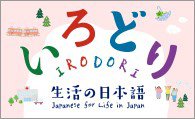
Japanese coursebook, Irodori: Japanese for Life in Japan
The IRODORI Japanese Online Course (August issue, Nihongo Kyoiku Tsushin) is a course for acquiring comprehensive Japanese language skills based on the coursebook Irodori: Japanese for Life in Japan. It can be used to study Japanese anytime, anywhere using smartphones, computers and tablets. As of May 2021, the Elementary 1 (A2) course is offered with explanations in Japanese and English languages. The Elementary 2 (A2) course is scheduled to open in October 2021. Going forward, we plan to offer courses in Chinese, Indonesian, Khmer, Mongolian, Myanmar, Nepali, Thai and Vietnamese languages as well.
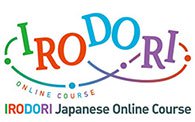
IRODORI Japanese Online Course
The JFT-Basic website also contains a "Hint for Learning" page introducing materials that are useful for preparing for the JFT-Basic, a link to an "Operating Guide video" explaining how to use the CBT screen and question screen, as well as a section with "Sample Questions," where questions in all the categories can be experienced in a format close to the actual test screen. Currently, the website can be read in eight languages aside from Japanese. Please do access the website to learn more about JFT-Basic.
- Reference information on Marugoto:
-
- 1.See the following for more information about JFT-Basic.
Kumano, N., Toda, T., Adachi, S. (2021) Development of the Japan Foundation Test for Basic Japanese: Computer-Based Testing (CBT) to Measure A2 Level Japanese Language Proficiency Required for Life in Japan. The Japan Foundation Japanese-Language Education Bulletin, Volume 17. - 2.Refer to the Test Implementation Report at the JFT-Basic website for details on test implementation.
- 1.See the following for more information about JFT-Basic.
(TODA Toshiko and KUMANO Nanae/Japanese education specialists,
The Japan Foundation Japanese-Language Institute, Kansai)
- What We Do Top
- Arts and Cultural Exchange [Culture]
- Japanese-Language Education Overseas [Language]
- Japanese-Language Education Overseas [Language] Top
- Learn Japanese-language
- Teach Japanese-language
- Take Japanese-Language Test
- Know about Japanese-language education abroad
- The Japanese-Language Institute, Urawa
- The Japanese-Language Institute, Kansai
- Japanese-Language Programs for Foreign Specified Skilled Worker Candidates
- Japanese Language Education for Japanese Children Resident Overseas and for the Descendants of Migrants
- Archives
- Japanese Studies and Global Partnerships [Dialogue]
- JF digital collection
- Other Programs / Programs to Commemorate Exchange Year
- Awards and Prizes
- Publications

